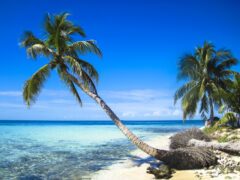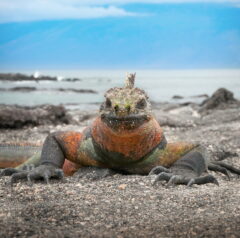Nicaragua: Contra to Expectations

On my second morning in Nicaragua I was held up at a roadblock and came face to face with the devil.
The roadblock was mounted not by soldiers in fatigues but by grinning schoolchildren in the national uniform of navy and white, taking part in a telethon. And the devil? In a church, I found a depiction of the temptation of Christ: with that virile moustache, piercing eyes and beaky nose, the devil was the spitting image of José Daniel Ortega Saavedra, the president of Nicaragua.
Daniel Ortega is used to being demonised - but by the United States. He was a leader of the Sandinista Revolution of 1978-79 that ended 40 years of dictatorship by the Somoza family, a dynasty which, it is said, owned only one farm but that farm was Nicaragua. If the Sandinistas’ swift spreading of literacy was miraculous, Ortega’s first spell as president, between 1985 and 1990, was closer to disastrous. Since being elected again last November, he has sold himself as a changed man. Nicaragua, the second poorest country in the hemisphere after Haiti, desperately needs jobs, electricity and infrastructure, and Ortega sees tourism as the means of providing them.
The British Foreign Office’s website says: "Road safety, or lack of it, is probably the biggest single hazard to travellers in Nicaragua." I found myself seconding that as my guide, Juan Carlos Mendoza, and I drove north to the coffee-growing country, with its fresh mountain air, then to two places that are hotter both in temperature and as tourist destinations: the colonial cities of León and Granada.
We encountered riderless ponies, stately oxen and families of four wobbling along on one bike. New roads were everywhere being built and old ones mended, but there were also craters and unmarked sleeping policemen that severely tested our Toyota saloon.
Students were a presence in both cities. In León they were Nicaraguan, gathered in groups of four or five, sharing a litre bottle of the local beer, Victoria, at circular tables; in Granada they were American. Granada, with horse-drawn carts that give it a distinctive sound and smell, is more immediately appealing. It’s shadier, too. León is a place of stifling heat, but it has a soul that hasn’t yet been mortgaged to tourism.
On Lake Nicaragua, we took a boat trip through Las Isletas - little islands formed 2,000 years ago when Mombacho volcano blew its top into the lake, and which are a refuge for weekenders and wildlife.Within half an hour we had seen three types of egret - great, little and snowy - a green-backed heron, a white-throated magpie jay, a family of spider monkeys, and a great kiskadee flycatcher, guarding its nest on a tipsy navigation marker.
That evening, I walked at spider monkey height at Morgan’s Rock, a 4,000-acre private reserve with views over a semi-circular beach and the Pacific. A suspension bridge links its rooms - or, rather, bungalows - with its restaurant.
In my bungalow, with its king-size bed, sofa bed, solar-heated shower and fussily sculpted taps, I was a prince, albeit an awkwardly solitary one, for Morgan’s is most popular with honeymooners.
The Victoria Hotel in El Castillo was more modest, beyond the reach of interior designers, but compensating in the warmth of its manager, Magdalena, for anything it lacked in frills.
From Managua, El Castillo is a 45-minute flight to the grass airstrip of San Carlos, followed by a five-minute taxi ride, followed by a three-hour boat trip along the Río San Juan, which forms the border with Costa Rica. I sat on the right behind the co-pilot, perfectly placed to snap the volcanoes of Ometepe Island, Concepción and Maderas, shouldering through cotton-wool clouds.
El Castillo, a settlement of stilted houses with tin roofs, is named for its fort, which was once captured by Nelson. On its ramparts in late afternoon I was transfixed by an osprey’s eye view of the river, a mini Amazon snaking sparkling through the green. I tore myself away only for a feast of river shrimps, which were as big and as succulent as promised.
We headed next for the Solentiname Archipelago, in the south-east of Lake Nicaragua, an area whose lush vegetation and bird life are wonderfully captured on canvas.
On arriving there in the 1960s, Ernesto Cardenal, priest, poet and minister of culture under the revolution, began a movement in which artistic schooling and talent have been passed down through the generations.
On La Venada island, we met two of its graduates, Rodolfo Arellano, 66, and his 20-year-old grandson, Julio. I bought one of Julio’s paintings, reminiscent of the landscapes of Rousseau but brighter, lighter, its trees teeming with wildlife, from monkeys to deer to the purple gallinule, a bird that, by this stage, despite its shyness and without my resorting to binoculars, I had managed to see in the wild on three occasions.
For that and other experiences, I felt privileged to have visited Nicaragua. I felt apprehensive, too, on its behalf. It is a beautiful and well preserved country partly because it is a poor and underdeveloped one. You can see how needed tourists dollars are, but also the damage that might be done in pursuit of them. Already, on the Pacific coast, ecologically minded hoteliers are complaining that ugly apartment blocks are popping up like toast.
In Solentiname, tourism is still low-key. On San Fernando island, Juan Carlos and I ordered dinner for seven o’clock. An hour later we were still waiting, for all hands were at the pump. To ensure we could shower, a pipeline into the lake was being extended - in the dark.
Next morning, low water was again a problem: as we returned from an outing our boat got stuck in the lake’s shallows and we had to get out and push. But no one minded, for the outing had been Julio’s painting come to life. Eduardo Mairena, whose family owns the cabins we stayed in, had taken us into the Río Papaturro, a narrow rush-lined river in the Los Guatuzos Wildlife Reserve. Eduardo had promised great wildlife-watching. He certainly delivered.
In a couple of hours we saw howler monkeys, turtles, cayman, Jesus Christ lizards and iguana, several species of heron and kingfisher, and - half a dozen times - a blackbird that, because of the bright red chevron on its wing, is known as the sargento or sergeant. "Many sergeants," Eduardo joked. "The army is on the river now." It’s the sort of army for which, I hope, Nicaragua will soon be better known.
By Michael Kerr, Telegraph Deputy Travel Editor.
Tailor-made holidays
Flexible, custom-made holidays to Latin America created to match your exact requirements: our tailor-made itineraries are as unique as the clients for whom they are designed.
Design my tripPapagaio
Your edit for Latin American inspiration
Our exciting range of articles on Latin America explore everything from iconic destinations and lesser-known cultural gems to delicious traditional recipes. You’ll also find exclusive travel tips, first-hand client reviews and the chance to get your personal questions answered by our travel experts.
View Extraordinary Inspiration






































